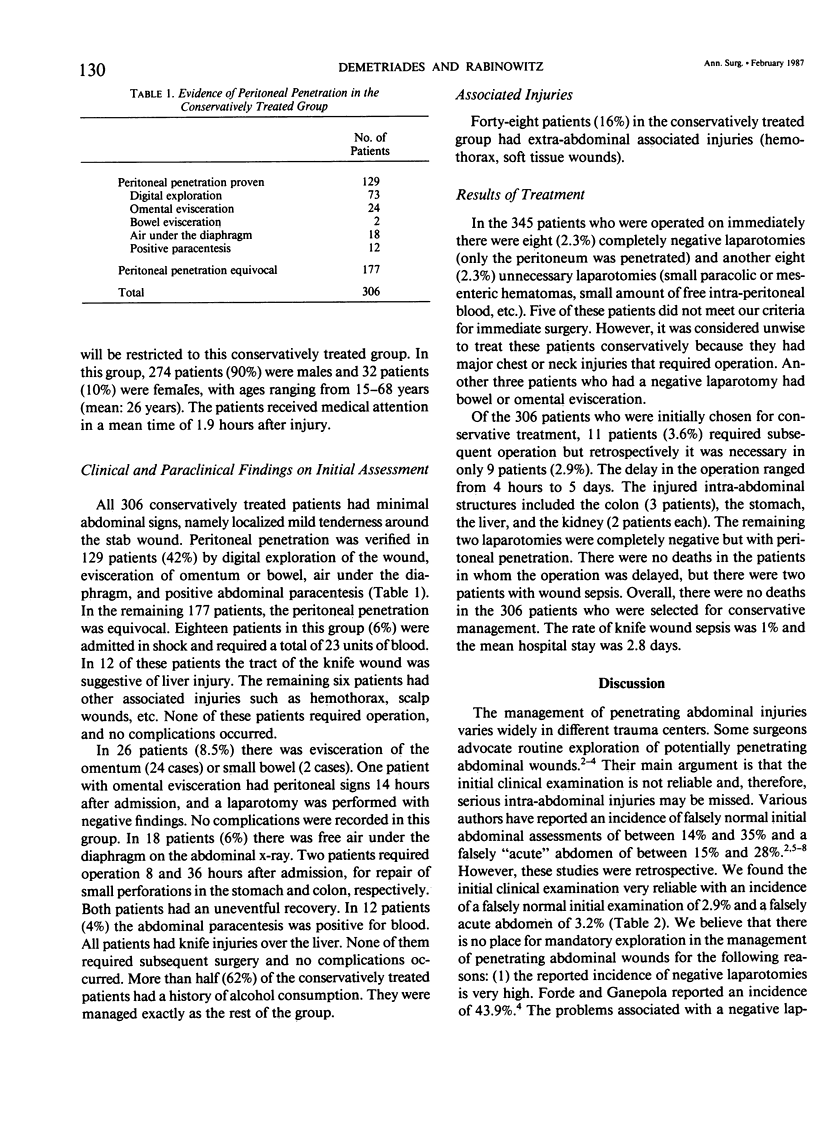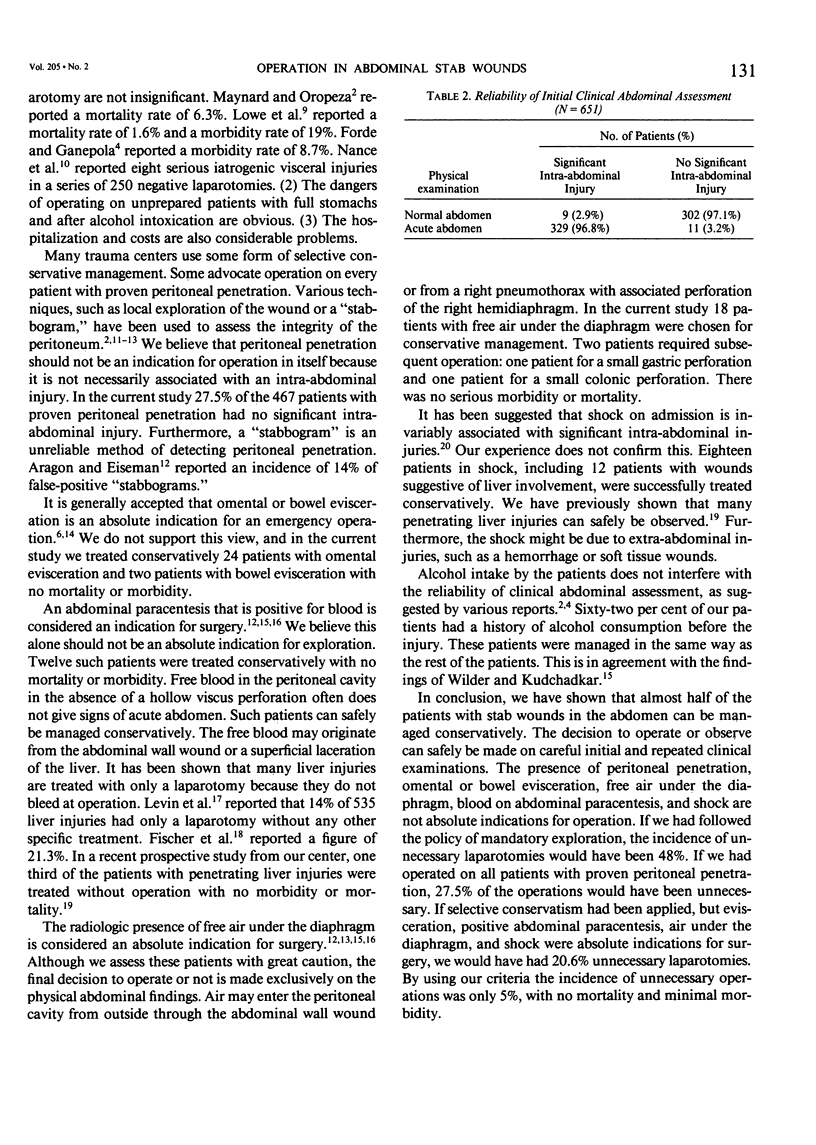Abstract
This prospective study comprises 651 patients with knife wounds of the anterior abdomen. Three hundred and forty-five patients (53%) had symptoms of an acute abdomen on admission and were operated on immediately. The remaining 306 patients (47%) were managed conservatively with serial clinical examinations. This group included 26 patients with omental or intestinal evisceration, 18 patients with air under the diaphragm, 12 patients with blood found on abdominal paracentesis, and 18 patients with shock on admission. Only 11 patients (3.6%) needed subsequent operation, and there was no mortality. The overall incidence of unnecessary laparotomies was 5% (completely negative, 3%). Of the 467 patients with proven peritoneal penetration, 27.6% had no significant intra-abdominal injury. It is concluded that many abdominal stab wounds can safely be managed without operation. The decision to operate or observe can be made exclusively on clinical criteria. Peritoneal penetration, air under the diaphragm, evisceration of omentum or bowel, blood found on abdominal paracentesis, and shock on admission are not absolute indications for surgery. Alcohol consumption by the patient does not interfere with the clinical assessment.
Full text
PDF



Selected References
These references are in PubMed. This may not be the complete list of references from this article.
- Aragón G. E., Eiseman B. Abdominal stab wounds: evaluation of sinography. J Trauma. 1976 Oct;16(10):792–797. [PubMed] [Google Scholar]
- Bull J. C., Jr, Mathewson C., Jr Exploratory laparotomy in patients with penetrating wounds of the abdomen. Am J Surg. 1968 Aug;116(2):223–228. doi: 10.1016/0002-9610(68)90497-2. [DOI] [PubMed] [Google Scholar]
- Cornell W. P., Ebert P. A., Greenfield L. J., Zuidema G. D. A new nonoperative technique for the diagnosis of penetrating injuries to the abdomen. J Trauma. 1967 Mar;7(2):307–314. doi: 10.1097/00005373-196703000-00013. [DOI] [PubMed] [Google Scholar]
- Demetriades D., Rabinowitz B. Selective conservative management of penetrating abdominal wounds: a prospective study. Br J Surg. 1984 Feb;71(2):92–94. doi: 10.1002/bjs.1800710204. [DOI] [PubMed] [Google Scholar]
- Demetriades D., Rabinowitz B., Sofianos C. Non-operative management of penetrating liver injuries: a prospective study. Br J Surg. 1986 Sep;73(9):736–737. doi: 10.1002/bjs.1800730919. [DOI] [PubMed] [Google Scholar]
- Donaldson L. A., Findlay I. G., Smith A. A retrospective review of 89 stab wounds to the abdomen and chest. Br J Surg. 1981 Nov;68(11):793–796. doi: 10.1002/bjs.1800681112. [DOI] [PubMed] [Google Scholar]
- Fischer R. P., O'Farrell K. A., Perry J. F. The value of peritoneal drains in the treatment of liver injuries. J Trauma. 1978 Jun;18(6):393–398. doi: 10.1097/00005373-197806000-00003. [DOI] [PubMed] [Google Scholar]
- Forde K. A., Ganepola G. A. Is mandatory exploration for penetrating abdominal trauma extinct? The morbidity and mortality of negative exploration in a large municipal hospital. J Trauma. 1974 Sep;14(9):764–766. doi: 10.1097/00005373-197409000-00004. [DOI] [PubMed] [Google Scholar]
- Garland J. B. Stab-wounds and other penetrating injuries of the abdomen and thorax. Postgrad Med J. 1968 Feb;44(508):127–133. doi: 10.1136/pgmj.44.508.127. [DOI] [PMC free article] [PubMed] [Google Scholar]
- Granson M. A., Donovan A. J. Abdominal stab wound with omental evisceration. Arch Surg. 1983 Jan;118(1):57–59. doi: 10.1001/archsurg.1983.01390010043010. [DOI] [PubMed] [Google Scholar]
- Hopson W. B., Sherman R. T., Sanders J. W. Stab wounds of the abdomen: 5-year review of 297 cases. Am Surg. 1966 Mar;32(3):213–218. [PubMed] [Google Scholar]
- Levin A., Gover P., Nance F. C. Surgical restraint in the management of hepatic injury: a review of Charity Hospital Experience. J Trauma. 1978 Jun;18(6):399–404. doi: 10.1097/00005373-197806000-00004. [DOI] [PubMed] [Google Scholar]
- Lowe R. J., Boyd D. R., Folk F. A., Baker R. J. The negative laparotomy for abdominal trauma. J Trauma. 1972 Oct;12(10):853–861. doi: 10.1097/00005373-197210000-00004. [DOI] [PubMed] [Google Scholar]
- MOSS L. K., SCHMIDT F. E., CREECH O., Jr Analysis of 550 stab wounds of the abdomen. Am Surg. 1962 Jul;28:483–489. [PubMed] [Google Scholar]
- Maynard A. de L., Oropeza G. Mandatory operation for penetrating wounds of the abdomen. Am J Surg. 1968 Mar;115(3):307–312. doi: 10.1016/0002-9610(68)90149-9. [DOI] [PubMed] [Google Scholar]
- McAlvanah M. J., Shaftan G. W. Selective conservatism in penetrating abdominal wounds: a continuing reappraisal. J Trauma. 1978 Mar;18(3):206–212. doi: 10.1097/00005373-197803000-00010. [DOI] [PubMed] [Google Scholar]
- Nance F. C., Wennar M. H., Johnson L. W., Ingram J. C., Jr, Cohn I., Jr Surgical judgment in the management of penetrating wounds of the abdomen: experience with 2212 patients. Ann Surg. 1974 May;179(5):639–646. doi: 10.1097/00000658-197405000-00017. [DOI] [PMC free article] [PubMed] [Google Scholar]
- Thal E. R. Evaluation of peritoneal lavage and local exploration in lower chest and abdominal stab wounds. J Trauma. 1977 Aug;17(8):642–648. doi: 10.1097/00005373-197708000-00012. [DOI] [PubMed] [Google Scholar]
- Wilder J. R., Kudchadkar A. Stab wounds of the abdomen. Observe or explore? JAMA. 1980 Jun 27;243(24):2503–2505. [PubMed] [Google Scholar]


